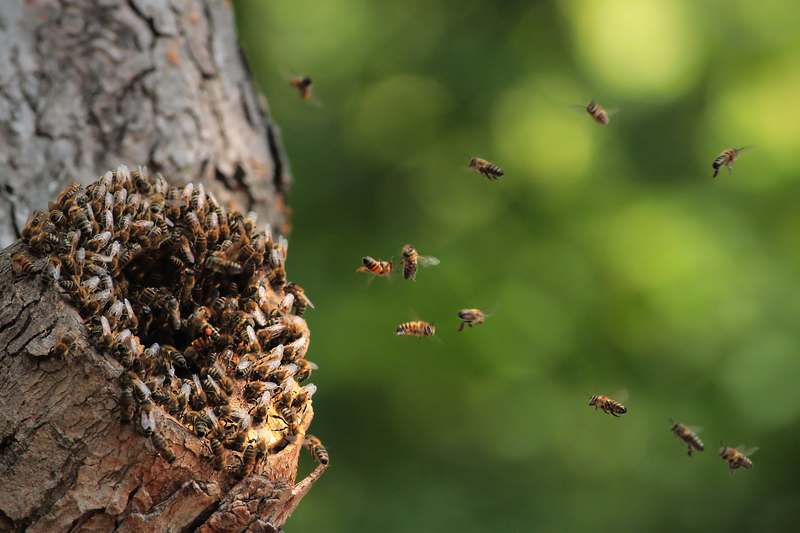Cultivate Change: Gardens in the Climate Fight
Posted on 19/09/2025
Cultivate Change: Gardens in the Climate Fight
The climate crisis is one of the most pressing challenges our world faces today. With rising temperatures, unpredictable weather patterns, and increased carbon emissions, the urgency to adopt sustainable solutions is greater than ever. But while large-scale policies and innovations are crucial, change often starts at home--and in our gardens. In this comprehensive article, we'll explore how cultivating gardens can be a powerful tool in the fight against climate change, unpack practical steps for making your green space climate-friendly, and highlight emerging trends shaping the future of sustainable gardening.

Why Gardens Matter in the Climate Crisis
Green Spaces as Carbon Sinks
Gardens have the extraordinary potential to act as carbon sinks. When plants--whether flowers, grasses, shrubs, or trees--photosynthesize, they absorb carbon dioxide (CO2) from the atmosphere and store it in their leaves, stems, roots, and the surrounding soil. While vast forests and wetlands are often considered the earth's main carbon banks, urban and suburban gardens collectively make a significant impact.
- Soil sequestration: Healthy garden soils store and retain more carbon.
- Perennial plantings: Deep-rooted perennials and trees lock away more carbon than annuals.
- Composting: Garden composts reduce landfill waste and enrich the soil's ability to store carbon.
Increasing Biodiversity: Gardens as Refuges
A thriving garden isn't just about aesthetics. It's a critical refuge for pollinators, birds, and countless other species whose habitats are threatened by urban expansion and climate change.
- Pollinator-friendly gardens support bees, butterflies, and other crucial insects.
- Native plantings boost local biodiversity and create habitats for wildlife.
- Healthy ecosystems in your yard can make neighborhoods more resilient to extreme weather events.
The Power of Regenerative Gardening To Combat Climate Change
From Traditional to Regenerative
The conventional approach to gardening--using synthetic fertilizers, chemical pesticides, and frequent watering--can be counterproductive when it comes to sustainability. Regenerative gardening, by contrast, is designed to restore, renew, and revitalize natural resources. It is a cornerstone in the movement to fight climate change through individual and community action.
- Permaculture principles: Mimic natural systems for a self-sustaining garden.
- No-dig gardening: Reduces soil disturbance, protecting soil carbon stocks.
- Composting & mulching: Build healthy soil, foster microbial life, and reduce waste.
- Organic growing: Avoids harmful chemicals that pollute the air and water.
How Your Garden Can Reduce Your Carbon Footprint
A climate-friendly garden can go beyond sequestering carbon. It can significantly reduce your household's direct and indirect emissions.
- Produce homegrown food: Skip the fossil fuels used in transporting groceries by growing vegetables, herbs, and fruit at home.
- Harvest rainwater: Reduce dependence on energy-intensive municipal water systems.
- Shade and cooling: Strategically placed trees and shrubs lower home cooling costs.
By cultivating food, composting, and making informed planting decisions, your garden becomes part of a global solution for climate action.
Practical Steps to Cultivate Change in Your Garden
Selecting the Right Plants
One of the most impactful actions garden owners can take in the climate fight is choosing the right plants for their environment.
- Native species: These plants are adapted to local conditions, require less water, and support native pollinators.
- Drought-tolerant varieties: Ideal for regions facing water scarcity and more frequent heatwaves.
- Perennials and trees: Outlive annuals, locking away more carbon over time.
*Consider a mix of edible and ornamental plants for maximum biodiversity and utility.*
Soil Health: The Hidden Weapon
Healthy soil is the unsung hero in climate-friendly gardening. Soil teems with life--bacteria, fungi, and worms--that work together to store carbon, retain moisture, and nourish plants.
- Avoid tilling: Tilling disrupts soil structure and releases stored carbon.
- Top with mulch: Mulch insulates the soil, conserves water, and prevents erosion.
- Compost: Add organic matter and reduce methane-emitting landfill waste.
- Plant cover crops: Prevents soil erosion and adds nutrients back into the soil during offseasons.
A garden rich in unturned, organic matter-filled soil transforms into a robust ally in the climate struggle.
Water-Wise Gardening Solutions
With shifting rainfall patterns and prolonged droughts, water conservation is essential in the climate fight. Smart gardening techniques can drastically improve your garden's water efficiency.
- Rain barrels: Capture runoff for use in dry periods.
- Drip irrigation: Delivers water directly to the roots, reducing waste and evaporation.
- Mulching and ground covers: Retain soil moisture and reduce the need for watering.
- Graywater reuse: Safely channel water from sinks and showers to irrigate non-edible garden areas.
*Every drop saved is a step closer to a more resilient garden ecosystem.*
Reduce, Reuse, Recycle--In the Garden
Resourcefulness is key in climate-conscious gardening. Sustainability often starts with making the most of what you have.
- Repurpose containers: Old buckets, tubs, or even broken ceramics can become planters.
- Upcycle garden tools and furniture instead of buying new.
- Create wildlife habitats by leaving a woodpile or stone heap for beneficial insects.
*By recycling and reusing, you reduce waste, conserve energy, and encourage a circular economy--even in the comfort of your garden.*
The Role of Community Gardens in Climate Action
Collective Impact Through Shared Spaces
Community gardens are springing up everywhere--from city rooftops to suburban parks. These shared spaces are not just about fresh produce or beautification; they're hubs for environmental activism and education.
- Urban greening: Community gardens buffer heat, filter air, and mitigate the urban heat island effect.
- Food justice: Provide access to healthy food in underserved neighborhoods, reducing food miles and packaging waste.
- Environmental literacy: Teach new generations about sustainable living and climate resilience.
- Disaster resilience: Shared knowledge and resources help communities withstand climate-related disruptions.
By joining or supporting a local gardening initiative, you magnify the climate impact of your individual actions and build stronger, more resilient communities.
Climate-Resilient Garden Design Strategies
Design for Sustainability
Welcome to the future of gardening--one where climate resilience and biodiversity are at the core of each decision. By incorporating eco-conscious design principles, you can future-proof your garden against extreme weather and support the broader fight against the climate emergency.
- Layered planting: Trees, shrubs, and groundcovers provide windbreaks, reduce erosion, and create microclimates.
- Wildlife corridors: Link green spaces to help species migrate and adapt to a changing climate.
- Edible landscapes: Blend food-producing plants with ornamentals to improve food security.
- Low-mow lawns: Replace high maintenance turf with meadows or native grasses that require less water and fertilizer.
*Thoughtful garden design, rooted in sustainability, not only prevents further environmental harm but actively reverses existing damage.*
Tech and Innovation in Climate-Smart Gardening
Emerging technologies are transforming how we approach gardening for the climate fight.
- Smart irrigation: Internet-connected sensors optimize watering and prevent overuse.
- Vertical farming and hydroponics: Use less space and water for food crops, ideal for urban environments.
- Soil health apps: Monitor pH, nutrients, and moisture for optimal growth with minimal resource use.
As innovation accelerates, the accessibility of climate-smart gardening tools will only expand, making it easier for everyone to participate in the fight against climate change.
Case Studies: Gardens That Inspire Sustainable Change
Urban Food Forests in Atlanta
Atlanta's urban food forests have transformed vacant city lots into productive, climate-friendly gardens. These forests:
- Support native biodiversity through layered plantings
- Tackle urban heat by lowering ambient temperatures
- Produce fresh, local food with a low carbon footprint
Backyard Pollinator Gardens in the UK
Across Great Britain, homeowners are turning their lawns into wildflower meadows and pollinator havens. These climate initiatives:
- Increase insect and bird populations
- Require less mowing, conserving fuel and emissions
- Educate communities about ecosystem interdependence

The Future of Gardens in the Climate Movement
What does the future hold for gardens in the fight against climate change? As more people embrace sustainable gardening, a new vision is emerging:
- Resilient neighborhoods: Gardens buffer weather extremes and foster community self-reliance.
- Healing urban landscapes: More greenery restores soil, cleans air, and provides shade.
- Nature-based solutions: Mainstreaming gardens as natural infrastructure in city planning.
*From backyard plots to citywide green corridors, gardens are poised to become primary agents of environmental restoration and climate stability.*
Conclusion: Every Garden Counts in the Climate Fight
The climate crisis can seem overwhelming, but hope springs eternal--in every seed sown and every garden tended. By cultivating change through climate-friendly gardening, individuals and communities become powerful forces for sustainability and resilience. Whether you nurture a single raised bed or collaborate in a bustling community plot, your actions reverberate collectively.
Cultivating gardens transforms more than landscapes--it transforms mindsets, builds connections with nature, and roots entire communities in the struggle for a cooler, greener, and more sustainable planet. Start today, and let your garden join the global climate fight.
Keywords: cultivate change, gardens in the climate fight, sustainable gardening, climate-friendly gardens, regenerative gardening, climate action, carbon sequestration, biodiversity, water-wise gardening, community gardens.



